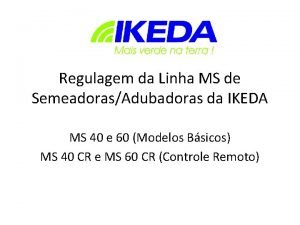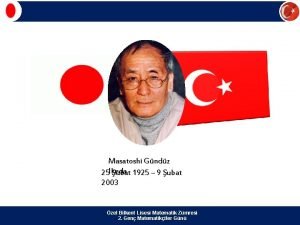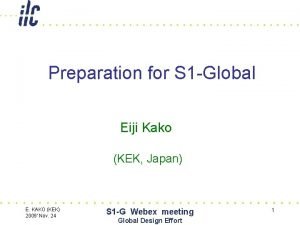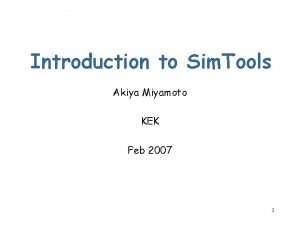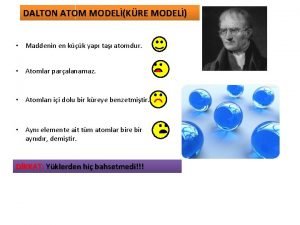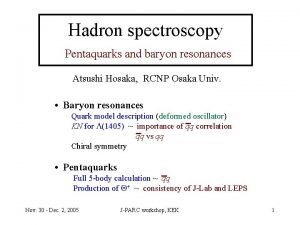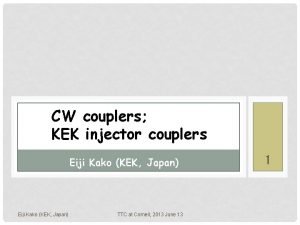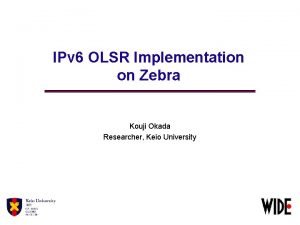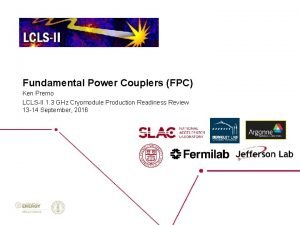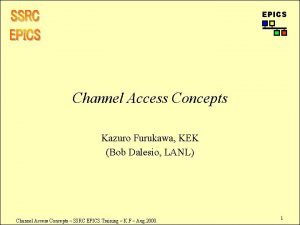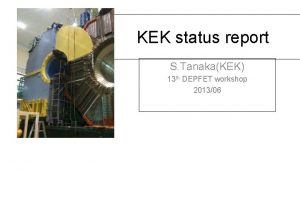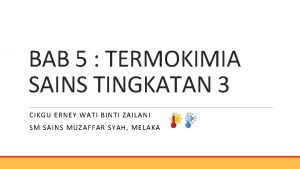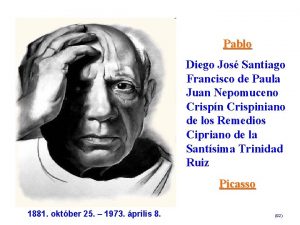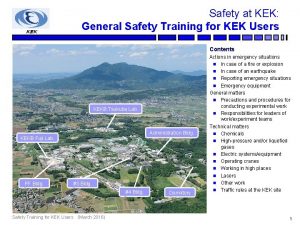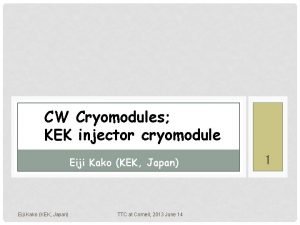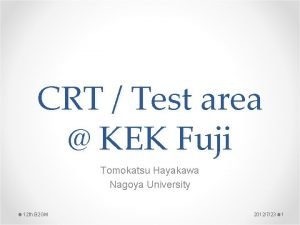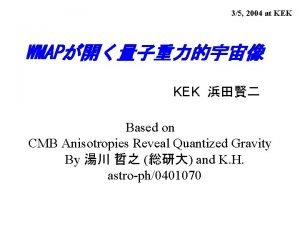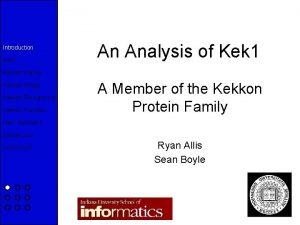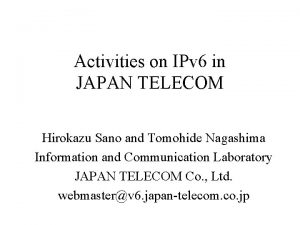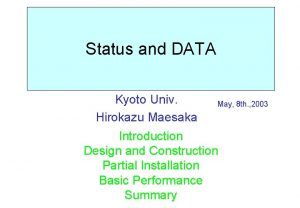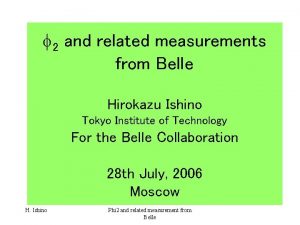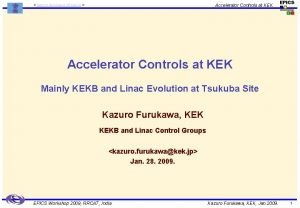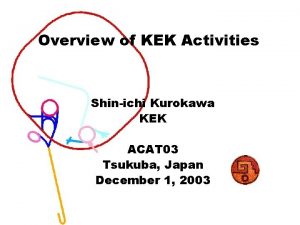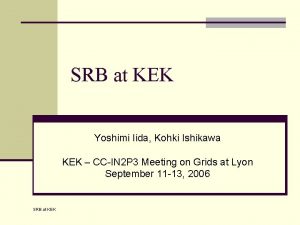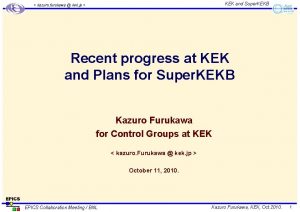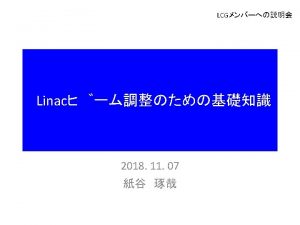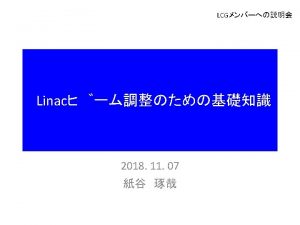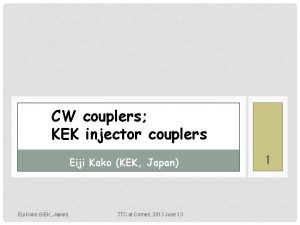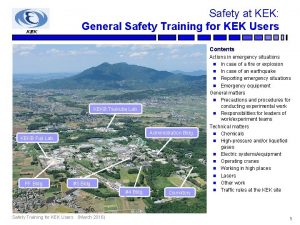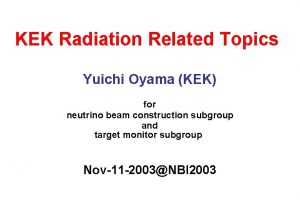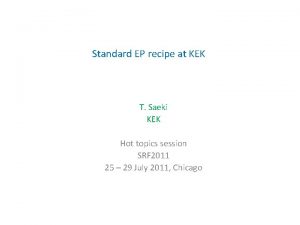Introduction to AnalogVLSI Design Hirokazu Ikeda ikedapost kek






























- Slides: 30

Introduction to Analog-VLSI Design Hirokazu Ikeda ikeda@post. kek. jp IPNS, High Energy Accelerator Research Organization July 28, 2003 @Riken 1

Contents for talk Title: Introduction to analog-VLSI design 1) What is CMOS? 2) Design flow (with examples) 3) Multi-chip project provided by VDEC 4) Recent progress: IP and Pixel 2

What is CMOS? (1) CMOS is a silicon-based integrated circuit fabrication technology with complementary FETs PMOS Transistor NMOS Transistor Field Oxide 3

What is CMOS? (2) General: 1)Conformance with very high integration with very low power consumption. 2) Complicated analog-digital circuits are allowed to be mixed together 3) Fabrication process is well matured. 4) Easy to be destructed by static discharge 5) Difficult to implement large capacitors and high resistors. 6) Allowable power-rail voltage is relatively low. 7)Absolute value for elements is very poor, while matching is excellent. 8) Radiation tolerance is being improved. Specific parameters for 0. 35 um CMOS from RHOM Gate oxide: 7. 2 nm Gate length: 0. 4 mm Metal width: 0. 6 mm Metal spacing: 1 mm Resistor: 2. 35 k. W/□ Capacitor: 1. 8 f. F/mm 2 Power rail: 2. 7 -3. 6 V 4

Design Flow 1)Making-up Spec’s 2)Functional description 3)Transistor-based description+verification 4)Layout design +verification 5)Silicon Process ( front-end, back-end) 6)Delivery to designers 5

Functional Description(1) The first step of circuit design is to construct a signal chain with ideal elements such as VCCS’s, VCVS’s, resistors, and capacitors. VCVS 前置増幅器 整形増幅器 ポール・ゼロ補償 Pole/zero canceller Preamplifier 非反転増幅器 Integrator and Amplifier 6

Functional Description(2) Generation of SPICE-netlist * SPICE netlist written by S-Edit Win 32 7. 03. SUBCKT Ideal. Op VINN VINP VOUT Gnd Simulation Program, Integrated Circuit Emphasis e 1 VOUT Gnd VINP VINN 10000. ENDS. SUBCKT Pre. Amp IOUT VIN Gnd g 1 IOUT Gnd VIN Gnd 2 m. ENDS. SUBCKT Sig. Chain AIN AOUT MON 1 MON 2 Gnd X 1 MON 1 AIN Gnd Pre. Amp X 2 N 3 Gnd MON 2 Gnd Ideal. Op X 3 N 1 MON 2 AOUT Gnd Ideal. Op C 1 AIN MON 1 0. 2 p. F C 2 N 3 5 p C 3 N 3 MON 2 0. 5 p R 4 AIN MON 1 210 Meg TC=0. 0, 0. 0 * Main circuit: T 000 R 5 N 3 MON 2 5 Meg TC=0. 0, 0. 0 X 1 N 1 OUT MON 1 MON 2 Gnd Sig. Chain R 6 N 1 AOUT 6 K TC=0. 0, 0. 0 C 1 TP N 1 0. 2 p. F R 7 Gnd N 1 2 K TC=0. 0, 0. 0 . op RP MON 1 N 2 500 K TC=0. 0, 0. 0 v 2 TP Gnd pulse(0. 0 36 m 100 n 10 n 100 u 200 u) RZ MON 1 N 3 7. 9 Meg TC=0. 0, 0. 0 . tran 10 n 50 u . ENDS . print tran v(VTP) v(MON 1) v(MON 2) v(OUT) * End of main circuit: T 000 7

Functional Description(3) Execution of SPICE with functional description; confirming whether the description is exactly what you want to do. V(OUT) Example of the pole/zero adjustment V(MON 2) V(MON 1) V(TP)

Functional description(4) Electronic noise is inherent to electronic devices and is enhanced by detector capacitance and leakage current. Calibration Pulse for normalization Noise spectrum Integrated noise 9

Transistor-based circuit design The step is to assemble MOSFET’s to implement required functions as specified or implied 1) W/O large capacitors, and high resistors 2) DC, AC, Transient, & Noise analysis for circuit blocks, signal chains, and finally entire chip. 2) Analysis with SKEW(FAST, TYPICAL, SLOW) parameter is a mandatory part. 3) Monte-Carlo analysis is available if required. 4) Temperature dependence, power-rail dependence, and/or bias current sensitivities should be checked out as a part of final confirmation. 10

Resistance Circuit(1) The resistance circuit exhibits a resistor-like behavior for its one terminal while the other terminal is kept as high impedance. In general the current generated by a resistor is utilized only one terminal of the resistance device; on the other terminal the current is no more than an annoyance. The resistance circuit can be controlled to exhibit resistance of 10 k. W to 500 MW. Our concern is just the KCL On this node. 11

Resistance circuit(2) AC analysis

Resistance Circuit (3) DC analysis

Preamplifier(1) Preamplifier is an integrator circuit to gather charges generated in a detector medium with very low electronic noise. 1) The input transistor employed is a p. MOS with W=15 um, L=0. 5 um, and M=50. 2)The amplifier takes a folded-cascode configuration. 3)The large input transistor suppresses electronic noise associated with the detector capacitance. 4) PMOS is known to exhibit lower 1/f noise than NMOS with less influence due to radiation. Constant current with cascode Input transistor Cascode transistor Constant current 14

Preamplifier(2) Adding a resistance circuit as well as a feed-back capacitance. Reference circuit Transient Analysis Test Pulse Feed-back capacitance 15

Preamplifier(3) Additional noise sources contribute to the total noise in one way or another. Noise Analysis AGAIN! Noise estimated preliminarily Noise after assembled 16

Preamplifier(4) The SKEW parameters provide modified SPICE parameters corresponding to the deviation of the silicon process SKEW Simulation W/ Temperature dependence W/ Radiation damage As for the 3 by 3 combinations for the SKEW parameters, the offset is severely affected to request a provision of an offset compensation, while the time constant is affected slightly. 17

LAYOUT Design LAYOUT design is a step to draw mask geometries for a photo-lithography It happens the case that the layout design is asked to be finished by an out-side expert; the circuit design should be well documented prior to initiating the layout design. 1) Examples (Preamplifier, Resistance circuit, and etc) 2) DRC 3) LVS 18

LAYOUT for Preamplifier Dummy 19

LAYOUT for Resistance Circuit 20

LAYOUT for Digital Circuits Layout for digital circuits is denser than that for analog circuits 21

DRC is a step to eliminate violations against the design-rule. 22

LVS is a step to verify conformance between the layout design and the SPICE netlist Extracted netlist C 79 VSS 16 C 80 VSS 16 C 81 VSS 16 C 82 VSS 16 C 83 VSS 17 C 84 VSS 17 C 85 VSS 18 C 86 VSS 19 C 87 VSS 16 C 88 VSS 16 C 89 VSS 16 C 90 VSS 16 C 91 VSS 17 C 92 VSS 17 C 93 VSS 18 1. 99800 E-13 1. 99800 E-13 CC 1 CC 2 CC 3 CC 4 CC 5 CC 6 CC 7 CC 8 CC 9 CC 10 CC 11 CC 12 CC 13 CC 14 CC 15 CC 16 CC 17 CC 18 CC 19 CC 20 CC 21 CC 22 CC 23 CC 24 CC 25 RLO VM 2. 69280 E-16 CC 26 RLO VDD 3. 93420 E-15 CC 27 RLO AIN 7. 99200 E-16 CC 28 RLO VSS 1. 28943 E-14 CC 29 VM VDD 5. 61180 E-15 CC 30 VM AIN 7. 99200 E-16 CC 31 VM VSS 1. 26425 E-14 CC 32 AIN VDD 4. 84440 E-15 CC 33 AIN VSS 5. 41248 E-15 CC 34 AIN 15 2. 46144 E-15 CC 35 AIN 24 2. 87500 E-16 CC 36 AOUT VDD 1. 59840 E-15 CC 37 AOUT VSS 4. 07737 E-14 CC 38 AOUT C 0 2. 36160 E-16 CC 39 AOUT C 1 5. 71680 E-16 CC 40 AOUT C 2 5. 71680 E-16 CC 41 AOUT C 3 5. 71680 E-16 CC 42 AOUT 13 1. 20960 E-15 CC 43 AOUT 15 3. 10768 E-15 CC 44 C 0 VDD 6. 27600 E-16 CC 45 C 0 VSS 1. 65874 E-14 CC 46 C 0 C 1 1. 52280 E-16 CC 47 C 0 C 2 1. 52280 E-16 CC 48 C 0 C 3 1. 52280 E-16 CC 49 C 1 VDD 6. 27600 E-16 CC 50 ST RA C 1 C 1 C 2 C 2 C 3 11 11 12 12 13 13 13 14 14 15 VSS 1. 94140 E-14 C 2 1. 52280 E-16 C 3 1. 52280 E-16 VDD 6. 27600 E-16 VSS 2. 16160 E-14 C 3 1. 52280 E-16 VDD 6. 27600 E-16 VSS 2. 59496 E-14 VDD 3. 97345 E-14 VSS 3. 34900 E-15 13 9. 07200 E-16 15 2. 41920 E-15 VDD 2. 01848 E-15 VSS 4. 18735 E-14 13 1. 22085 E-15 20 1. 20960 E-15 21 9. 07200 E-16 29 2. 87500 E-16 30 2. 87500 E-16 VDD 7. 01411 E-15 VSS 2. 07688 E-14 22 3. 02400 E-16 VDD 5. 71456 E-15 22 3. 02400 E-16 VDD 2. 87840 E-15 YC AP AC ITA CC 51 CC 52 CC 53 CC 54 CC 55 CC 56 CC 57 CC 58 CC 59 CC 60 CC 61 CC 62 CC 63 CC 64 CC 65 CC 66 CC 67 CC 68 CC 69 CC 70 NC 15 15 15 16 16 17 17 18 18 19 19 20 21 22 23 26 27 28 29 30 E VSS 7. 73580 E-15 24 1. 21120 E-15 25 1. 21120 E-15 VDD 1. 33974 E-13 VSS 2. 25064 E-14 VDD 6. 69872 E-14 VSS 1. 05768 E-14 VDD 3. 34936 E-14 VSS 4. 61200 E-15 VDD 2. 31392 E-14 VSS 4. 61200 E-15 VSS 6. 26770 E-15 VSS 4. 70260 E-15 VDD 2. 40430 E-15 VDD 1. 19240 E-15 VSS 8. 91600 E-16 VSS 8. 54000 E-16 VSS 8. 91600 E-16 If everything is OK, the sing-off condition is met. C 0 N 1 Vss 0. 2 p. F C 1 N 5 Vss 0. 4 p. F C 2 N 4 Vss 0. 8 p. F C 3 N 3 Vss 1. 6 p. F 23

Silicon Process and Assembly 24


Development of front-end IP Front-end is a circuit directly connected to a radiation detector. IP stands for Intellectual Properties; specifically reusable sub-circuit designs organized to be ready for migrated use. From ASIC’s designed for special purpose 1) 2) 3) Multi-channel signal processing circuit for Cd. Te X-ray detector. Timing/amplitude readout circuit for 3 D pixel detector. Digital readout circuit for HPD array device. Reusable circuit blocks such as 1) Amplification elements 2) Reference circuits 3) Logic gates 4) I/O pads, and etc are extracted for later use The labor loads save in this approach are deployed for still unexplored circuit elements, which are applied for new circuit design. 26

Pixel readout design in progress In place of Conclusion/summary 1) 2) 3) 4) 4) 5) 6) 7) 260 mm by 260 mm Preamplifier Shaping amplifier CR-RC 3 Peak-hold circuit Comparator Analog multiplexer Trim-DAC/registers 27/E


Pole/zero canceller Preamplifier 3 rd integrator 1 st integrator 2 nd integrator Peak-hold circuit

 Dr csiki vanda
Dr csiki vanda Regulagem ikeda
Regulagem ikeda Masatoşi gündüz ikeda hayatı
Masatoşi gündüz ikeda hayatı Kako kek
Kako kek Kek.manet
Kek.manet Kek tools
Kek tools Dalton atom modeli üzümlü kek
Dalton atom modeli üzümlü kek Kek
Kek Kek
Kek Kako kek
Kako kek Kek manet
Kek manet Premo kek
Premo kek Bob kek
Bob kek Kek 13
Kek 13 Tindak balas endotermik sains tingkatan 3
Tindak balas endotermik sains tingkatan 3 Kek gem
Kek gem Kek
Kek Picasso vasalónő
Picasso vasalónő Kekkh nyilvántartás
Kekkh nyilvántartás Kek n
Kek n Kek kds
Kek kds Kako kek
Kako kek Futaba kek
Futaba kek Kek based
Kek based Essay structure
Essay structure Introduction of system analysis and design
Introduction of system analysis and design Layout design rules
Layout design rules Introduction to interior design
Introduction to interior design An introduction to design science
An introduction to design science Design introduction
Design introduction Introduction to elements of design
Introduction to elements of design

